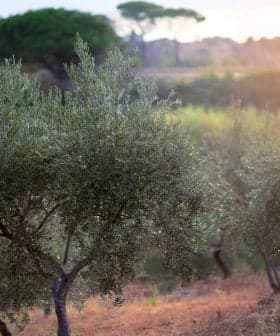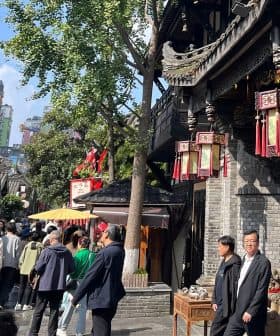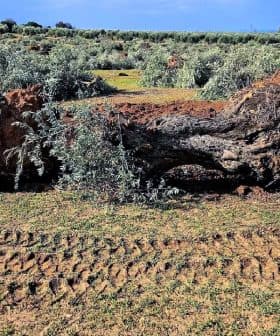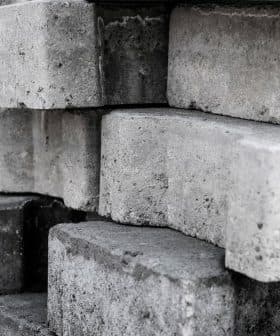Plant-Derived Treatment Against Asian Bug Shows Promise for Olive Growers
A blend of 11 odorant compounds produced naturally by sunflowers was found to attract female brown marmorated stink bugs. The concoction could be used in traps.
 Brown marmorated stink bug
Brown marmorated stink bug Researchers in Canada have discovered that odorants released by sunflowers can help control the brown marmorated stink bug, an invasive species that causes significant damage to crops. The study found that a specific blend of odorants from blooming sunflowers can attract the insects and potentially be used in traps to reduce their populations and protect valuable crops.
Researchers in Canada have demonstrated that odorants released by sunflowers may provide an organic solution to the growing problems caused by the brown marmorated stink bug (Halyomorpha halys).
Native to Japan, China and the Korean Peninsula, the insect has spread widely from East Asia in the last decades to North America and the European Union.
The invasive species have become a scourge for farmers as the larvae, and adult insects feed on a range of high-value crops. The insects’ presence has been repeatedly associated with the green drop of olive fruit, a condition in which unripe drupes fall to the ground and become unusable.
See Also:Olive Pests and Disease Will Be Focus of International Conference in OctoberHowever, a newly-published study in the Journal of Chemical Ecology suggests that the odors of certain chemicals released by sunflowers as they bloom may help curb the insects’ reproduction.
Researchers from Simon Fraser University’s biological science research department examined the olfactive reactions of the brown marmorated stink bug to different stages of development of the dwarf sunflower (Helianthusannuus).
The scientists investigated the insect’s behavior in still-air laboratory conditions, with four potted sunflowers at distinct phenological stages (vegetative, pre-bloom, bloom and seeding).
They found that most females were attracted to the blooming plants but deposited their eggs evenly on all four.
The researchers then introduced the insects to a moving-air two-choice olfactometer experiment, which tested their level of attraction to each phenological stage and compared the results to the still-air trial.
“Blooming sunflowers performed best overall, but no one plant stage was most attractive in all experiments,” the researchers wrote.
They captured and analyzed the headspace odorants of each plant stage, finding that sunflowers had an increase in odor-emitting compounds, including monoterpenes, in the transitioning phase from pre-bloom to bloom.
The researchers then focused on finding the correct mix of the odorants to attract the insects.
“Analyzing the headspace odorant blend of blooming sunflower by gas chromatographic-electroantennographic detection revealed 13 odorants that consistently elicited responses from female H. halys antennae,” the researchers wrote. “An 11-component synthetic blend of these odorants attracted H. halys females in laboratory olfactometer experiments.”
The resulting blend could be deployed in traps that would attract brown marmorated stink bugs, keeping them away from the most valuable crops.
“Particularly in spring, a simpler yet fully effective sunflower semiochemical blend could be developed and coupled with synthetic H. halys aggregation pheromones to improve monitoring efforts or could improve the efficacy of modified attract-and-kill control tactics for H. halys,” the researchers wrote.
In Italy alone, the brown marmorated stink bug causes about €85 million worth of damage to the agriculture sector each year.
According to the U.S. Environmental Protection Agency, the insect has been identified in 38 states and the District of Columbia, with farmers reporting damage to various field crops, fruits and vegetables.
As a result, scientists are desperately seeking to reduce their populations, which often exceed those of endemic species.
One effort has seen Italian researchers introduce the samurai wasp, a natural predator of the brown marmorated stink bug.
The goal of its deployment is to contain the presence of the bug by at least 60 percent in most areas, but the experts said it would take a few seasons to determine whether the plan is working.
Share this article









